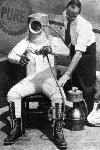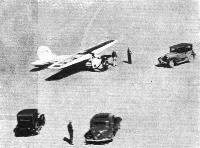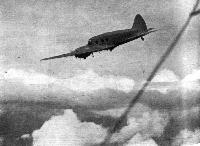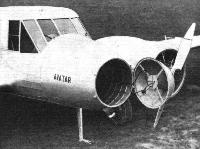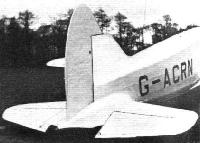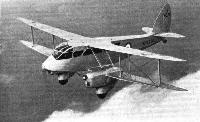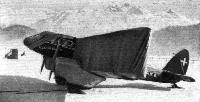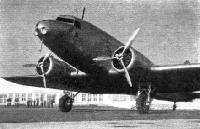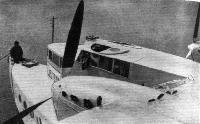Фотографии
-
Langley's tandem-winged machine of 1903.
Самолёты на фотографии: Langley Aerodrome - США - 1903
-
Регистрационный номер: NR105W [2] Wiley Post, the American pilot who has recently made several high-altitude flights, wearing his special suit which is supplied with air from one of the engine superchargers. The air is led to the helmet and exhausts via the boots
Самолёты на фотографии: Lockheed Vega - США - 1927
-
Регистрационный номер: NR105W [2] A "ONE-POINT LANDING": Wiley Post's Lockheed "Vega," Winnie Mae, after landing - minus the undercarriage - in the Mojave Desert, where it was forced down during an attempted stratosphere flight across America. Only slight damage was done to the airscrew. Note the skid mark in the sand.
Forced landing after sabotage, February 16, 1935Самолёты на фотографии: Lockheed Vega - США - 1927
-
The Focke-Wulf "Ente"
Самолёты на фотографии: Focke-Wulf F 19 Ente - Германия - 1927
-
The Blackburn T.S.R. Seaplane. The engine is a Siddeley "Tiger" of 700 h.p.
Самолёты на фотографии: Blackburn Shark / B-6 - Великобритания - 1933
-
Unusual float details: On the left is shown the spring-loaded water rudder and the hydraulic mechanism for operating the rudders. On the right is the special joint which has been designed to avoid "handing" the floats.
Самолёты на фотографии: Blackburn Shark / B-6 - Великобритания - 1933
-
ON THEIR LAWFUL OCCASIONS. A magnificent impression of a scene at Gibraltar during the Combined Exercises. The seaplane is a Fairey "Seal" (535 h.p. "Panther IIa") of the Fleet Air Arm. The rain-water catchment slope on the face of the Rock is clearly visible.
Самолёты на фотографии: Fairey Gordon / Seal - Великобритания - 1931
-
ON THE TIGRIS: One of the "Singapores" for No. 205 (F.B.) Squadron off Hinaidi. On board can be seen F/O. W. J. Hickey, Sqn. Ldr. A. F. Lang, M.B.E., and Mr. Oswald Short.
Самолёты на фотографии: Short Singapore III / S.19 - Великобритания - 1934
-
Utility duties - the new Grumman XJF-1 amphibian three seater. Its 950 h.p. "Twin Wasp" R-1830-62, gives a top speed of 197 m.p.h.
The Grumman JF1 has a top speed of 170 m.p.h.Самолёты на фотографии: Grumman JF / J2F Duck - США - 1933
-
One half of the undercarriage, the wheels of which retract flush with the float
Самолёты на фотографии: Grumman JF / J2F Duck - США - 1933
-
A portion of the wing structure.
Самолёты на фотографии: Grumman JF / J2F Duck - США - 1933
-
Регистрационный номер: G-ACRN [3] Самолёты на фотографии: Avro Anson / Type 652 - Великобритания - 1935
-
Регистрационный номер: G-ACRN [3] UP-TO-THE-MINUTE: Modern commercial monoplane practice is exemplified in every line of the new Avro 652, two of which have been built for charter work for Imperial Airways. The machine has two Siddeley "Cheetah" engines.
Самолёты на фотографии: Avro Anson / Type 652 - Великобритания - 1935
-
Mails or other light loads can be placed inside the nose through this door. For Imperial Airways a landing light has been fitted in the nose.
Самолёты на фотографии: Avro Anson / Type 652 - Великобритания - 1935
-
Регистрационный номер: G-ACRN [3] The auxiliary surfaces for trimming the elevators and the rudder can be seen in this photograph of the tail units.
Самолёты на фотографии: Avro Anson / Type 652 - Великобритания - 1935
-
The interior of the cabin of the Avro 652, as arranged for Imperial Airways. The walls are wood-panelled.
Самолёты на фотографии: Avro Anson / Type 652 - Великобритания - 1935
-
Full dual flying controls are provided in the pilots' cockpit
Самолёты на фотографии: Avro Anson / Type 652 - Великобритания - 1935
-
This drift sight is in the floor of the Avro 652, between the pilots' seats.
Самолёты на фотографии: Avro Anson / Type 652 - Великобритания - 1935
-
The cabin door of the Avro 652 is shaped to the wing-root fairing.
Самолёты на фотографии: Avro Anson / Type 652 - Великобритания - 1935
-
A spring lid covers the cabin door handle, leaving a clean exterior.
Самолёты на фотографии: Avro Anson / Type 652 - Великобритания - 1935
-
Two screw clips hold each side of the engine cowling and allow it to be readily detached.
Самолёты на фотографии: Avro Anson / Type 652 - Великобритания - 1935
-
This sketch and diagram explain the working of the retractable undercarriage, which is underneath the engine mounting.
Самолёты на фотографии: Avro Anson / Type 652 - Великобритания - 1935
-
Регистрационный номер: K5070 MILITARISED: The "Dragon Rapide" ordered for No. 24 (Communications) Squadron at Hendon.
Самолёты на фотографии: De Havilland Dragon Rapide / Dominie / D.H.89 - Великобритания - 1934
-
Регистрационный номер: HB-ARA SHROUDED: The D.H. "Dragon Rapide" now used by Aero St. Gallen on services between St. Gallen, Zurich and Berne. During 1934 this company, which also owns a "Puss Moth" and a "Leopard Moth" and which has been doing school and charter work since 1931, carried 3,393 passengers. The "Rapide" was recently flown by Capt. Rieser from St. Moritz to Zurich with a hospital case. There are no hangars at St. Moritz - hence the funereal appearance of their latest acquisition in this picture
Самолёты на фотографии: De Havilland Dragon Rapide / Dominie / D.H.89 - Великобритания - 1934
-
One of Swissair's new Douglas machines at Zurich.
Самолёты на фотографии: Douglas DC-1 / DC-2 / C-32 / C-39 - США - 1933
-
Регистрационный номер: G-AAXC DEMONSTRATION: One of the two Swissair Douglas machines, which were demonstrated recently at Croydon, being refuelled beside the Imperial Heracles. Actually, the "Scylla" class will probably be used, as last year, for our own part of the Zurich service. The Government has offered a prize of ?25,000 to encourage the production of medium-sized commercial machines.
Самолёты на фотографии: Douglas DC-1 / DC-2 / C-32 / C-39 - США - 1933Handley Page H.P.42 / H.P.45 - Великобритания - 1930
-
FOR AIR FRANCE. The Potez 62, a fourteen-passenger commercial adaptation of the maker's multiplace de combat type. Its two 900 h.p. "Mistral Major" two-row radials give a cruising speed of 175 m.p.h. The normal range is 625 miles and the ceiling 26,000 ft.
Самолёты на фотографии: Potez Potez 62 / 65 - Франция - 1935
-
DEMONIACAL VERSATILITY. The first of the eighteen Hawker "Demon" two-seaters ordered by the Royal Australian Air Force is here seen being tested by Mr. M. Summers. These machines, which can be equipped for fighting, bombing, or for army co-operation work, are powered with the Rolls-Royce "Kestrel V" engine, supercharged to give a maximum of 640 h.p. at 14,000 ft. The top speed is in the neighbourhood of 190 m.p.h.
Самолёты на фотографии: Hawker Demon - Великобритания - 1932
-
Flying at 50 m.p.h.: The "Gull" with split trailing-edge flaps down.
Самолёты на фотографии: Percival Gull - Великобритания - 1932
-
Регистрационный номер: G-ADEP The modern trend in cabin and open types is illustrated in this type, the Percival Gull.
Самолёты на фотографии: Percival Gull - Великобритания - 1932
-
"Open House": Note the size of the doors. The smaller door at the back gives access to the luggage locker.
Самолёты на фотографии: Percival Gull - Великобритания - 1932
-
The 1935 "Gull": Note the new windscreen, which has been found to shed the rain and leave the view unimpaired.
Самолёты на фотографии: Percival Gull - Великобритания - 1932
-
A view showing the trailing-edge flaps.
Самолёты на фотографии: Percival Gull - Великобритания - 1932
-
Light and Comfort: A view from above, looking into the cabin.
Самолёты на фотографии: Percival Gull - Великобритания - 1932
-
The "trousered" undercarriage and its details.
Самолёты на фотографии: Percival Gull - Великобритания - 1932
-
The tail units. Note the castering tail wheel.
Самолёты на фотографии: Percival Gull - Великобритания - 1932
-
Percival "Gull" 1935 Model "Gipsy VI" Engine
Самолёты на фотографии: Percival Gull - Великобритания - 1932
-
DOUGLASIAN: On the power of two 700 h.p. geared and supercharged radials (which are Pratt & Whitney "Hornets" built under licence) the new Fiat G.18 shown here has a maximum speed of 210 m.p.h. carrying eighteen passengers, luggage and mail with fuel for 500 miles
Самолёты на фотографии: FIAT G.18 - Италия - 1935
-
[DGA-6] Mr. "Benny" Howard's latest racing machine,
Самолёты на фотографии: Howard DGA-6, -7, -8, -11, -12 - США - 1935
-
Регистрационный номер: G-AAXE The nose of the Imperial Airways H.P.42 Hengist, showing the rotating loop aerial used in conjunction with the Marconi-Robinson homing device.
Самолёты на фотографии: Handley Page H.P.42 / H.P.45 - Великобритания - 1930
-
The wireless cabin of an Imperial Airways H.P.42, showing the Marconi Type A.D. 41/42 equipment, with homing device (at top). The aerial winch can be seen by the door leading to the pilots' compartment.
Самолёты на фотографии: Handley Page H.P.42 / H.P.45 - Великобритания - 1930
-
The "Leopard Moth," on the aerodrome at Belp, with Mr. Fawcett's companion and Herr W. Eberschweiler.
Самолёты на фотографии: De Havilland Leopard Moth / D.H.85 - Великобритания - 1933
-
Mt. Blanc (15,780 ft.) towering above a sea of clouds - a photograph by DOUGLAS FAWCETT.
Самолёты на фотографии: De Havilland Leopard Moth / D.H.85 - Великобритания - 1933
-
SILHOUETTE: A fine impression of four Blackburn "Baffin" (Bristol "Pegasus M") torpedo-bombers from H.M.S. Furious on early patrol during the recent Combined Fleet Exercises.
Самолёты на фотографии: Blackburn Baffin / B-5 - Великобритания - 1933
-
The H.S.T. 10, the new high-speed commercial monoplane is rapidly taking form in the Blackburn works. The point at which the Duncanson single spar for the wing is offered up into the fuselage will be noticed. Fitted with two Napier "Rapier VI" engines, the machine is expected to have a cruising speed of 175 m.p.h.
Самолёты на фотографии: Blackburn B-9 / HST.10 - Великобритания - 1936
-
Регистрационный номер: G-ACUX GOLD RUSH: This particular Short "Scion," fitted with floats, is to be used for gold survey in Papua.
Самолёты на фотографии: Short Scion / S.16 - Великобритания - 1933
-
Самолёты на фотографии: Fairchild C-31 / Model 95 - США - 1934
-
The capacious "hold" of the C-31. Note the folding wall seats in the "hold," for troop-carrying purposes.
Самолёты на фотографии: Fairchild C-31 / Model 95 - США - 1934
-
The cockpit of the C-31. Dual controls are not fitted.
Самолёты на фотографии: Fairchild C-31 / Model 95 - США - 1934
-
Регистрационный номер: F-AKFK In this Farman monoplane, specially built for high-altitude attempts, the pilot flew for a time with his head outside the cockpit; then, when sufficient height was gained to make risk of collision with other aircraft improbable, he lowered himself in the cockpit and shut an airtight door above his head.
Самолёты на фотографии: Farman F.1000 - Франция - 1932
-
The Mignet Pou-du-Ciel in flight
Самолёты на фотографии: Mignet Pou-de-Ciel / HM-14 - Франция - 1932
-
The latest tandem-wing development - M. Mignet's Pou-du-Ciel. The dihedral angle of the wings is not shown.
Самолёты на фотографии: Mignet Pou-de-Ciel / HM-14 - Франция - 1932
-
Mrs. S. M. BRUCE, the wife of the Australian High Commissioner, christens one of the Monospar S.T.12's which are bound for the Commonwealth. In the group may also be seen the Rt. Hon. S. M. Bruce, Mr. and Mrs. Gordon England, Mr. Whitney Straight, Mr. H. J. Steiger (Monospar technical director), and Flt.-Lt. H. M. Schofield.
Самолёты на фотографии: General Aircraft Monospar ST-4 - ST-12 - Великобритания - 1932
-
[HS.10/32] VERSATILITY : An Austrian mail pilot during the summer months, Hubert Kleinhaus joyrides in the winter from Kitzkeuhl and runs a service, when necessary, to St. Moritz. His machine - of distinctly familiar appearance - is a Hopfner "Superfly" with a Walter "Gamma" engine. Kleinhaus learnt to fly in Germany and took an aerobatic course in this country.
Самолёты на фотографии: Hopfner HS.8/29 / HS.10/32 - Австрия - 1928
-
FOR "SPORT-FLYING": Under the management of Mr. R. Kronfeld, production of the "Drone," an ultra-light aeroplane (600 c.c, 14 h.p. Douglas engine) has been resumed at Hanworth by B.A.C. Ltd. The machine was first designed by the late Mr. C. H. Lowe-Wylde. Mr. Kronfeld shortly hopes to make some long flights with the "Drone," which is a machine that should be most suitable for recreational flying and will be seen at most flying clubs during the coming season.
Самолёты на фотографии: Kronfeld Drone - Великобритания - 1932
-
LOOKING FORWARD: An unusual view of the new Latecoere 521 flying boat, Lieutenant de Vaisseau Paris, now undergoing trials, showing the pilots' compartment, and wireless cabin (in front of the former).
Самолёты на фотографии: Latecoere Late 521 / 522 / 523 - Франция - 1935
-
...AND NOW ITALY: One of the latest machines built to the modern formula for transport machines - i.e., two engines, cantilever wing and retractable undercarriage - is the Caproni 123. On 1,760 h.p., given by two Gnome Rhone K.14's, the machine cruises at 167 m.p.h.
Самолёты на фотографии: Caproni Ca.122 / Ca.123 - Италия - 1934
-
CZECHOSLOVAKIAN: Carrying from fourteen to sixteen passengers, the Aria 57, with three 575 h.p. radials of "Cyclone" type, cruises at 180 m.p.h. Dr. Robert J. Nebesar, the designer of the machine, tells us he is quite satisfied with the results of test flights.
Самолёты на фотографии: Avia Av.57 - Чехословакия - 1935
-
A Flight artist's impression of the Asboth helicopter, drawn from plans of the Hungarian inventor. The two sets of rotor blades revolve in opposite directions, thus cancelling out torque reaction.
Самолёты на фотографии: Asboth helicopter - Австрия - 1935
-
An artist's impression of the "Crusader." The undercarriage is shown extended.
Самолёты на фотографии: American Gyro AG-4 Crusader - США - 1935
Статьи
- Flight
- Flight Advertisements

